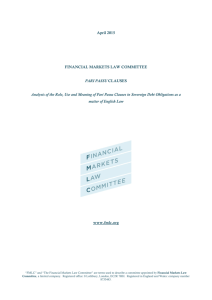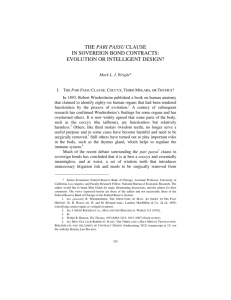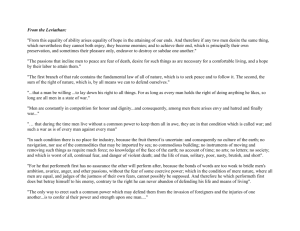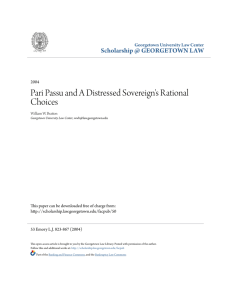Interpreting the Pari Passu Clause in Sovereign Bond Contracts: It's
advertisement
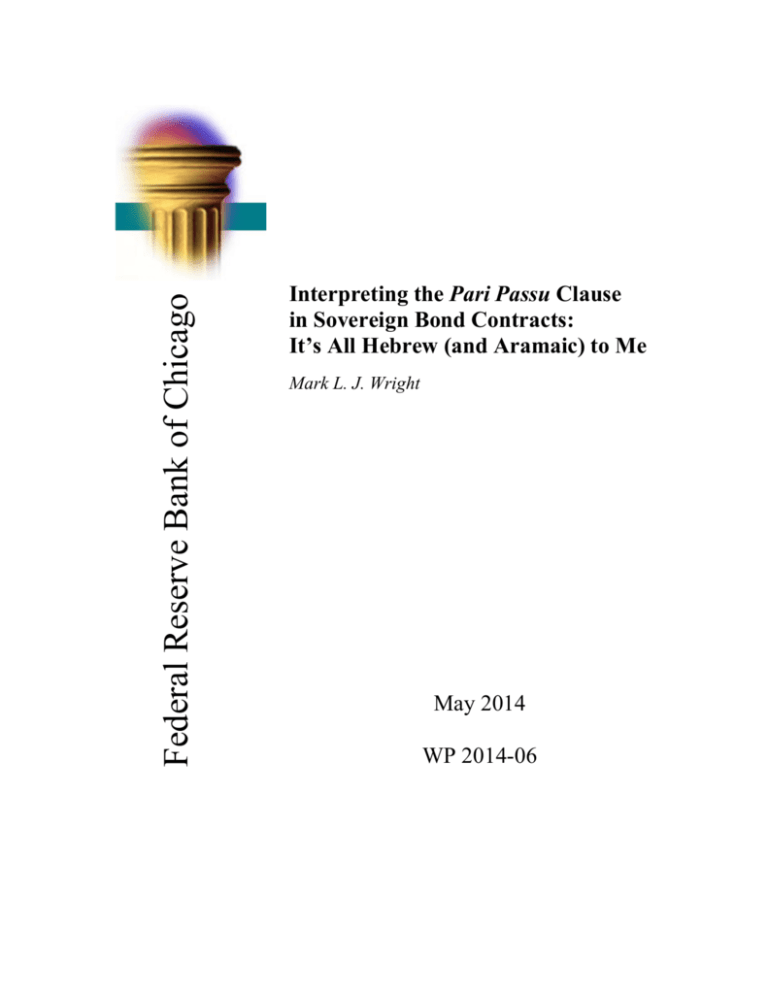
Federal Reserve Bank of Chicago Interpreting the Pari Passu Clause in Sovereign Bond Contracts: It’s All Hebrew (and Aramaic) to Me Mark L. J. Wright May 2014 WP 2014-06 May 4, 2014 Interpreting the Pari Passu Clause in Sovereign Bond Contracts: It’s All Hebrew (and Aramaic) to Me Mark L. J. Wright Federal Reserve Bank of Chicago, and National Bureau of Economic Research ABSTRACT In this comment, we take a helicopter tour of the history of notions of “equality” and “justice” in sovereign debt restructuring in particular, and in the division of property more generally, and show that these concerns have existed for centuries, if not millennia. We argue that the issue at stake in the interpretation of the pari passu clause is not so much the treatment of holders of identical claims— it is now customary to treat them identically— but whether the holders of di¤erent claims should be treated di¤erently. We show that exists a customary “principle of di¤erentiation” that allows creditors with claims that di¤er in speci…c ways to be treated preferentially. One of these speci…c di¤erences concerns debts that have been reduced in value during a previous debt restructuring or default, and based on this principle we conclude that the New York court has, if not completely misinterpreted the meaning of the pari passu clause, then at least misapplied it. Keywords: Sovereign debt restructuring, pari passu, Argentina, inter-creditor equity. JEL Codes: D63, F34, K12 To appear in the Capital Markets Law Journal. Senior Economist and Research Advisor, Federal Reserve Bank of Chicago, and Faculty Research Fellow at the National Bureau of Economic Research. I thank Mitu Gulati and Ben Chabot for comments. The views expressed in this paper are those of the author and do not necessarily represent those of the Federal Reserve Bank of Chicago, the Federal Reserve System, or the National Bureau of Economic Research. 1 Introduction Pari Passu: Nine letters arranged into four syllables constituting two little Latin words that translate roughly as “on equal footing”; Two little words that may have a giant e¤ect on international capital markets, for good or for ill. For depending on whom one believes, if the interpretation of the pari passu clause in sovereign bond contracts by a judge in the Southern District of New York1 is allowed to stand, these words will wreak havoc in the market for sovereign debt— by causing Argentina to default2 , hindering future sovereign debt restructuring operations3 , and leading sovereign bond issuers to abandon the New York markets4 — or else act as its savior— by strengthening creditor rights and allowing for less risky sovereign borrowing at lower interest rates.5 At issue is both the interpretation of the clause— what it means to place creditors “on equal footing”— and its implications— particularly the application of injunctive relief to third parties. Viewed in this context, the contribution of Chabot and Gulati6 is to further our understanding of the meaning of the pari passu clause. They exhibit the …rst known bond to use language similar in meaning to pari passu: holders of the Mexican Black Eagle bonds, issued in 1843, were to be treated with a “just equality”. Moreover, in documenting the context for the issue of this bond, they show that the clause was introduced in response to a debt restructuring that treated holders of identical claims di¤erently based on their country of residence. The implication is that the language was intended to ensure that holders of identical claims would be treated identically. 1 NML Capital Ltd. et al. v. Republic of Argentina, Nos. 08 Civ. 6978 (TPG), 09 Civ. 1707 (TPG), 09 Civ. 1708 (TPG) (S.D.N.Y. Nov. 11, 2012) and NML Capital Ltd. v. Republic of Argentina , Nos. 08 Civ. 6978 (TPG), 09 Civ. 1707 (TPG), 09 Civ. 1708 (TPG) (S.D.N.Y. Nov. 11, 2012). Excellent descriptions of the case can be found in Chabot and Gulati, in this volume, Gulati GM, Scott RE. 2011. The Three and a Half Minute Transaction: Biolerplate and the Limits of Contract Design, and in Gelpern A. 2013. Sovereign Damage Control. Peterson Institute for International Economics Policy Brief 13. 2 Steven M. Davido¤, Argentina Takes Its Debt Case to the U.S. Supreme Court, New York Times, 25th February 2014. 3 Felix Salmon, Argentina’s Stunning Pari Passu Loss, Reuters, October 27, 2013. 4 Br. Of Joseph Stiglitz in Support of Petitioner in Republic of Argentina v. NML Capital, Ltd ., No. 12 - 1494 (2d Cir. Jul. 26, 2013.) 5 Hans Humes and Diego Ferro “Why Argentina’s Behavior Must Not Be Allowed to Stand”, Financial Times Alphaville, 2nd April 2013, and more generally Shleifer A. 2003. Will the Sovereign Debt Market Survive? The American Economic Review 93: 85-90 and Dooley MP. 2000. International Financial Architecture and Strategic Default: Can Output Losses Following International Financial Crises be Avoided. Carnegie-Rochester Conference Series 53: 361-77. 6 “Santa Anna and his Black Eagle: The Origins of Pari Passu”, in this volume. In these brief comments, we take a helicopter tour of the history of notions of “equality” and “justice” in the division of property and show that these concerns have existed for millennia. We argue that the issue at stake is not so much the treatment of holders of identical claims— it is now customary to treat them identically— but whether the holders of di¤erent claims should be treated di¤erently. We show that there is a customary “principle of di¤erentiation” that allows creditors with claims that di¤er in speci…c ways to be treated preferentially. One of these speci…c di¤erences concerns debts that have been reduced in value during a previous debt restructuring or default, and based on this principle we conclude that the New York court has, if not completely misinterpreted the meaning of the pari passu clause, then at least misapplied it. In other words, the equality of treatment of both the unrestructured and restructured creditors of Argentina that the New York Courts are determined to enforce amounts to an unjust equality. 2 Justice, Equity, and Equality In The Division of Property From The Talmud to Today Credit market participants widely recognize the importance of concerns for justice, equality and equity in sovereign debt restructuring as re‡ected in the social norm of “intercreditor equity”7 . Indeed, modern sovereign bond and syndicated loan contracts routinely include a number of clauses, in addition to pari passu, designed to ensure that inter-creditor equity is preserved. In bonds, these include negative pledge clauses to ensure a debtor will not subsequently pledge its assets to future creditors8 , mandatory prepayment clauses requiring pro rata payments to all lenders in the event of a prepayment to any lender9 , cross-default clauses allowing any lender to declare a loan in default should the debtor default on any other loan and so prevent early defaulting loans from receiving better terms10 , and , in the case of syndicated sovereign loans, sharing clauses that explicitly ensured pro-rated payments in the 7 The Republic of Argentina, Reply Brief of Defendent-Appellant, NML Capital Ltd., Aurelius Capital Master, Ltd., — v. — The Republic of Argentina, at 2-3. 8 Lee C. Buchheit, Negative Pledge Clauses: The Games People Play, International Financial Law Review, July 1990, at 10. 9 Gulati & Scott, supra note 1, at 76-7. 10 Ibid, at 26 2 event of a default. 11 As documented by Chabot and Gulati, these concerns were very much active in the early Nineteenth Century as well. Santa Anna’s decree of 11th May 1843 stated that it aimed to “establish a just equality amongst the creditors, as much as regards the rate of interest as the order of payment”(emphasis added). Moreover, the decree refers to an “equitable . . . distribution”of funds. Although not appearing as a contract provision in the “Black Eagle” bonds of 1843, similar language did appear in the pre-amble of these bonds. But what does “just equality”mean in the context of a sovereign debt restructuring? What does “inter-creditor equity” mean? For that matter, what does it mean to promise to place creditors “on equal footing”? Does “equality” mean that all creditors should be paid the same absolute dollar (or Euro or peso etc.) amount regardless of the size and form of their claim? Or does it mean that they should receive a payment that represents an equal proportion of their claim? And if it is to be an equal proportion, what should it be proportional to? Should it be proportional to the face value of the debt? Or to the present value calculated using some discount rate? The market values prior to the default being announced? Or does “just equality” recognize that there should some explicit di¤erences in treatment allowed in order to account for di¤erences in the underlying forms of a sovereign’s debt? If all creditor claims are identical, both in size and in form, all of these alternatives de…nitions of “just equality” are identical. But creditor claims are rarely identical, di¤ering in both size (the value of the claim) and form (the currency of issue, maturity, security, treatment in a previous debt restructuring, and so on). Even in the simplest case, where the only di¤erence is in the size of each creditor’s claim, disagreements as to how to distribute shares of a property amongst rival claimants have been going on for, quite literally, millennia. Perhaps the best documented examples come from the Babylonian Talmud, written (in both Hebrew and Aramaic) between the 3rd and 5th Centuries of the Common Era. The Talmud contains several examples of the disposition of rival claims of di¤erent sizes to a common property.12 In some cases, the Talmud 11 Lee C. Buchheit, Changing Bond Documentation: The Sharing Clause, International Financial Law Review, July 1998, at 17. 12 Kethubot 93a, describes a bankruptcy problem; Bava Metzia (2a) concerns rival claims on a garment; 3 speci…es that all creditors should receive an equal absolute amount independent of the size of their claim. In others, the creditors were to receive a payment that was proportional to the size of their claim. In still other cases, the payments are neither equal in absolute terms, or in proportion. Whether these di¤erences re‡ect special circumstances applying to each claim that are not made explicit in the Talmud,13 or re‡ect a sophisticated game-theoretic mechanism for discriminating between claims,14 they illustrate the di¢ culties associated with …nding “just”settlements. By contrast, in the context of sovereign debt restructuring there appears to be widespread agreement on how to deal with claims that are similar in form but di¤erent in size: each creditor should receive an amount that is an equal proportional of their total claim. This form of “just equality” between identical creditors appears repeatedly throughout history, and violations of this principle have resulted in strong protests. In the Mexican Eagle case, it was not the default by Mexico that stimulated British diplomatic intervention and threats of military sanctions; rather it was the di¤erent treatment of British bondholders from other creditors with identical claims.15 When in 1934 Germany announced plans to suspend payments on its foreign loans, the US Secretary of State expressed regret at the losses in‡icted upon American investors; it was only when Germany announced plans to discriminate against holders of the American tranches of the Dawes and Young loans that both the American Ambassador to Germany and the Secretary State wrote condemn the departure from “unconditional equality” and the violation of the pari passu clause.16 When the Dominican Republic swapped two similar bonds paying 4% interest into bonds paying di¤erent rates of interest in 1897, the (predominantly Belgian) bondholders that were to be discriminated against protested successfully.17 Similar cases, in which there were protests against discrimination between bondholdthe Tosefta to Bava Metzia, Yevamot (38a), concerns an estate; see Aumann RJ. 2002. Game Theory in the Talmud. Research Bulletin Series on Jewish Law and Economics 2002 and Aumann RJ, Maschler M. 1985. Game-Theoretic Analysis of a Bankrupcty Problem from the Talmud. Journal of Economic Theory 36: 195-213. 13 Shmuel and Rabbi Yaakov from Nekhar Pkod, in the Gemara, cited in Aumann Ibid. 14 See Aumann RJ ibid, and Aumann and Maschler supra n.12. 15 Chabot and Gulati, at 23. 16 S.J. Kim Pari Passu: The Nazi Gambit, in this volume, at 4-5, 8-9 17 Wynne WH. 1951. State Insolvency and Foreign Bondholders: Selected Case Histories of Governmental Foreign Bond Defaults and Debt Readjustments. New Haven, Connecticut: Yale University Press. at 222. 4 ers with similar claims, were su¢ ciently abundant that Borchard, in his ground-breaking analysis of sovereign insolvency in 1951, could state that there was a “principle of equality” across bondholders that applied to the resolution of sovereign defaults.18 But Borchard also went on to state that the “principle of equality ... does not signify uniformity of treatment”19 particularly when creditors’claims took di¤erent forms. That is, there was a complementary “principle of di¤erentiation”20 . The grounds for di¤erentiation, and in particular discrimination in favor of particular types of bonds, included di¤erences in the quality of the claim (such as the existence of a security interest)21 , the purpose of the loan (for example, short term loans to fund international trade or the basic operations of the government of the country)22 , and when the creditor was an international institution like the League of Nations or the International Monetary Fund.23 Of particular interest for the current case involving Argentina, claims that had already been reduced in value as a result of a prior default were often given preference.24 In summary, there exists a centuries-long social norm among participants in sovereign debt markets that holders of similar debts should be treated similarly, which is typically interpreted to mean that they should be repaid in proportion to their holdings of the debt (measured at face value plus deferred interest). There is also a social norm that creditors with di¤erent claims should, in many cases, be treated di¤erently. In the next section, we ask what this means for sovereign debt disputes today. 3 What Does this Mean for Argentina and Other Sovereigns Today? While the Black Eagle bond represents the …rst known statement of a principle of equality in the treatment of di¤erent creditors in the event of a sovereign default, it does not use the words pari passu. Chabot and Gulati argue that this “just equality”clause represents 18 Borchard E. 1951. State Insolvency and Foreign Bondholders: General Principles. New Haven: Yale University Press. at 337. 19 ibid at 337. 20 ibid at 340. 21 ibid at 339, 341, 356-7. 22 Ibid at 346-50. 23 Ibid at 341; Diego Saravia “On the role and e¤ects of IMF seniority” Journal of International Money and Finance 10/2010. 24 Borchard, n10 at 338-42, 357 n.62. 5 the spirit of (what they call the “concept”of) the pari passu clause. This argument is persuasive. The term “just equality”was introduced in response to protests against discriminatory treatment that explicitly used the language “equal footing”, and hence was likely viewed as synonymous by the bondholders at the time.25 Moreover, the …rst known pari passu clause in a sovereign bond was introduced under very similar circumstances to the Black Eagle bonds. In the same way that the just equality clause was introduced in response to past discrimination between holders of identical claims on the basis of their nationality, the …rst known use of an explicit pari passu clause was by Bolivia in 1872, a time in which concerns about discrimination between bondholders of di¤erent nationalities were also high following the collapse of plans to create an international bondholder body, and the rise of competing national bondholder groups like the British Council of Foreign Bondholders in 1868 (to become the Corporation of Foreign Bondholders in 1873).26 But as argued above, agreeing that the pari passu clause is intended to ensure a just equality between creditors would only appear to imply equal treatment of creditors that are holding identical (or at least very similar) claims. When creditors are holding distinctly di¤erent claims, discrimination appears to have been the rule. In the case of NML v Argentina, the plainti¤s are holding bonds that are in most cases identical to the ones previously held by the restructured creditors. The restructured creditors now hold bonds that are distinctly di¤erent, most importantly in the sense that they were reduced by almost 70% of their value. Treating these creditors “equally”based on their ex post (after restructuring) claims, as interpreted by the New York Court as implying equal proportionate payment, requires Argentina to pay in full the un-restructured claims of NML, while paying in full the much reduced claims of the restructured creditors. This is inconsistent with an ex ante (pre restructuring) “principle of equality”, as creditors with identical ex ante claims are being treated di¤erently. Moreover, it is inconsistent with an ex post “principle of di¤erentiation”, as it does not recognize the di¤erence between the restructured and un-restructured debts and in particular violates the custom of treating previously restructured creditors preferentially. 25 The language was used by both the London Times and the Chairman of the Committee of Spanish American Bondholders. Chabot and Gulati at 23. 26 Gulati and Scott supra note 1, and Wright MLJ. 2011. The Pari Passu Clause in Sovereign Bond Contracts: Evolution or Intelligent Design? Hofstra Law Review 40: 103-14 6 By contrast, the Republic of Argentina’s o¤er to give NML the same settlement terms as it agreed with the restructured creditors satis…es both an ex ante “principle of equality” (as holders of identical claims ex ante are being given the same treatment) and an ex post “principle of di¤erentiation” in that the previously restructured creditors are receiving the same amounts in absolute terms as NML, but are being awarded a higher (indeed, full) proportion of their ex post claims. 4 Concluding Thoughts One response to the surprising interpretation of the pari passu clause o¤ered by the New York Court is to advocate that sovereigns delete the clause from their sovereign bond contracts. However, unless the clause is replaced with a similar clause guaranteeing “just equality”, this is almost certainly a terrible idea. This is because there are at least two reasons to think that concerns for inter-creditor equity will only become increasingly important in the years ahead. The …rst reason is the increasingly widespread adoption of aggregation clauses in sovereign bond contracts. First introduced by Uruguay,27 aggregation clauses allow a supermajority of bondholders drawn from a set of potentially very di¤erent bonds to impose a restructuring on all bonds within the set. The Eurogroup has committed to introduce aggregation clauses into all Euro area bonds starting in 2013,28 which might lead to their more widespread adoption by other countries. And although these clauses often also require a super-majority of the holders of each bond to approve a restructuring, Greece used legislation to retroactively insert an aggregation clause into its own domestic law bonds that did not include this protection for each bond (nor did these bonds include a pari passu clause). As a consequence, the possibility that a supermajority of bondholders might impose an inequitable restructuring on a minority of bondholders has become more likely. The second reason is that there is already a precedent for the use of aggregation clauses to impose a highly discriminatory restructuring. The recent Greek debt restructuring, which made use of aggregation clauses, involved a large number of bonds with maturities ranging 27 Gulati and Scott supra note 1 at 169. Press Release, Eurogroup, Eurogroup Statement on European Financial Stabilization 1-2 (Nov. 28, 2010), http://www.consilium.europa.eu/uedocs/cms_data/docs/pressdata/en/eco…n/118050.pdf. 28 7 from the very short term up to 45 years.29 The bonds were mostly similar in form, except for di¤erences in their maturity. Despite their similarity, the degree of discrimination across these bonds was extreme: the private holders of some short term bonds had their value reduced by almost 90 percent, while the private holders of some long-dated debts had their claims reduced in value by less than 20 percent.30 And bonds held by some creditors, the European Central Bank, European national central banks, and the European Investment Bank, were not reduced in value at all despite being identical to bonds held by private creditors.31 This degree of discrimination appears to be unprecedented. 32 In summary, the evidence shows that concerns for inter-creditor equity or the “just equality”of treatment of creditors have been around for millennia and, in the case of sovereign borrowing, at least for centuries. Recent developments in sovereign debt markets suggest that these concerns may intensify in the future, emphasizing the importance of clarifying the meaning of the pari passu clause. In these notes, we have argued that this clause is only intended to ensure the identical treatment of creditors holding identical claims; when creditor claims di¤er, as they do in the Argentina case, creditors should be treated di¤erently, and custom dictates that the restructured creditors should be treated preferentially. After all, had the drafters of the pari passu clause wanted to ensure ratable payments across all creditor claims, they could have substituted two other little Latin words— pro rata— for pari passu. 29 33 Zettelmeyer J, Trebesch C, Gulati GM. 2013. The Greek Debt Restructuring: An Autopsy. Petersen Institute for International Economics Working Paper 13 at 21. 30 ibid at 21. 31 Although loans that originated from international organizations are typically treated preferentially, there is no known precedent for loans that originated from private sector creditors and that were subsequently acquired on secondary markets by international institutions to receive preferential treatment. 32 Zettelmeyer et al, supra note 29, n.27 at 21-2. 33 Indeed, some modern bonds speci…cally require ratable payment. See Tolek Petch “NML v. Argentina in an English Legal Setting” in this volume at 6. 8 Working Paper Series A series of research studies on regional economic issues relating to the Seventh Federal Reserve District, and on financial and economic topics. Corporate Average Fuel Economy Standards and the Market for New Vehicles Thomas Klier and Joshua Linn WP-11-01 The Role of Securitization in Mortgage Renegotiation Sumit Agarwal, Gene Amromin, Itzhak Ben-David, Souphala Chomsisengphet, and Douglas D. Evanoff WP-11-02 Market-Based Loss Mitigation Practices for Troubled Mortgages Following the Financial Crisis Sumit Agarwal, Gene Amromin, Itzhak Ben-David, Souphala Chomsisengphet, and Douglas D. Evanoff WP-11-03 Federal Reserve Policies and Financial Market Conditions During the Crisis Scott A. Brave and Hesna Genay WP-11-04 The Financial Labor Supply Accelerator Jeffrey R. Campbell and Zvi Hercowitz WP-11-05 Survival and long-run dynamics with heterogeneous beliefs under recursive preferences Jaroslav Borovička WP-11-06 A Leverage-based Model of Speculative Bubbles (Revised) Gadi Barlevy WP-11-07 Estimation of Panel Data Regression Models with Two-Sided Censoring or Truncation Sule Alan, Bo E. Honoré, Luojia Hu, and Søren Leth–Petersen WP-11-08 Fertility Transitions Along the Extensive and Intensive Margins Daniel Aaronson, Fabian Lange, and Bhashkar Mazumder WP-11-09 Black-White Differences in Intergenerational Economic Mobility in the US Bhashkar Mazumder WP-11-10 Can Standard Preferences Explain the Prices of Out-of-the-Money S&P 500 Put Options? Luca Benzoni, Pierre Collin-Dufresne, and Robert S. Goldstein WP-11-11 Business Networks, Production Chains, and Productivity: A Theory of Input-Output Architecture Ezra Oberfield WP-11-12 Equilibrium Bank Runs Revisited Ed Nosal WP-11-13 Are Covered Bonds a Substitute for Mortgage-Backed Securities? Santiago Carbó-Valverde, Richard J. Rosen, and Francisco Rodríguez-Fernández WP-11-14 The Cost of Banking Panics in an Age before “Too Big to Fail” Benjamin Chabot WP-11-15 1 Working Paper Series (continued) Import Protection, Business Cycles, and Exchange Rates: Evidence from the Great Recession Chad P. Bown and Meredith A. Crowley WP-11-16 Examining Macroeconomic Models through the Lens of Asset Pricing Jaroslav Borovička and Lars Peter Hansen WP-12-01 The Chicago Fed DSGE Model Scott A. Brave, Jeffrey R. Campbell, Jonas D.M. Fisher, and Alejandro Justiniano WP-12-02 Macroeconomic Effects of Federal Reserve Forward Guidance Jeffrey R. Campbell, Charles L. Evans, Jonas D.M. Fisher, and Alejandro Justiniano WP-12-03 Modeling Credit Contagion via the Updating of Fragile Beliefs Luca Benzoni, Pierre Collin-Dufresne, Robert S. Goldstein, and Jean Helwege WP-12-04 Signaling Effects of Monetary Policy Leonardo Melosi WP-12-05 Empirical Research on Sovereign Debt and Default Michael Tomz and Mark L. J. Wright WP-12-06 Credit Risk and Disaster Risk François Gourio WP-12-07 From the Horse’s Mouth: How do Investor Expectations of Risk and Return Vary with Economic Conditions? Gene Amromin and Steven A. Sharpe WP-12-08 Using Vehicle Taxes To Reduce Carbon Dioxide Emissions Rates of New Passenger Vehicles: Evidence from France, Germany, and Sweden Thomas Klier and Joshua Linn WP-12-09 Spending Responses to State Sales Tax Holidays Sumit Agarwal and Leslie McGranahan WP-12-10 Micro Data and Macro Technology Ezra Oberfield and Devesh Raval WP-12-11 The Effect of Disability Insurance Receipt on Labor Supply: A Dynamic Analysis Eric French and Jae Song WP-12-12 Medicaid Insurance in Old Age Mariacristina De Nardi, Eric French, and John Bailey Jones WP-12-13 Fetal Origins and Parental Responses Douglas Almond and Bhashkar Mazumder WP-12-14 2 Working Paper Series (continued) Repos, Fire Sales, and Bankruptcy Policy Gaetano Antinolfi, Francesca Carapella, Charles Kahn, Antoine Martin, David Mills, and Ed Nosal WP-12-15 Speculative Runs on Interest Rate Pegs The Frictionless Case Marco Bassetto and Christopher Phelan WP-12-16 Institutions, the Cost of Capital, and Long-Run Economic Growth: Evidence from the 19th Century Capital Market Ron Alquist and Ben Chabot WP-12-17 Emerging Economies, Trade Policy, and Macroeconomic Shocks Chad P. Bown and Meredith A. Crowley WP-12-18 The Urban Density Premium across Establishments R. Jason Faberman and Matthew Freedman WP-13-01 Why Do Borrowers Make Mortgage Refinancing Mistakes? Sumit Agarwal, Richard J. Rosen, and Vincent Yao WP-13-02 Bank Panics, Government Guarantees, and the Long-Run Size of the Financial Sector: Evidence from Free-Banking America Benjamin Chabot and Charles C. Moul WP-13-03 Fiscal Consequences of Paying Interest on Reserves Marco Bassetto and Todd Messer WP-13-04 Properties of the Vacancy Statistic in the Discrete Circle Covering Problem Gadi Barlevy and H. N. Nagaraja WP-13-05 Credit Crunches and Credit Allocation in a Model of Entrepreneurship Marco Bassetto, Marco Cagetti, and Mariacristina De Nardi WP-13-06 Financial Incentives and Educational Investment: The Impact of Performance-Based Scholarships on Student Time Use Lisa Barrow and Cecilia Elena Rouse WP-13-07 The Global Welfare Impact of China: Trade Integration and Technological Change Julian di Giovanni, Andrei A. Levchenko, and Jing Zhang WP-13-08 Structural Change in an Open Economy Timothy Uy, Kei-Mu Yi, and Jing Zhang WP-13-09 The Global Labor Market Impact of Emerging Giants: a Quantitative Assessment Andrei A. Levchenko and Jing Zhang WP-13-10 3 Working Paper Series (continued) Size-Dependent Regulations, Firm Size Distribution, and Reallocation François Gourio and Nicolas Roys WP-13-11 Modeling the Evolution of Expectations and Uncertainty in General Equilibrium Francesco Bianchi and Leonardo Melosi WP-13-12 Rushing into American Dream? House Prices, Timing of Homeownership, and Adjustment of Consumer Credit Sumit Agarwal, Luojia Hu, and Xing Huang WP-13-13 The Earned Income Tax Credit and Food Consumption Patterns Leslie McGranahan and Diane W. Schanzenbach WP-13-14 Agglomeration in the European automobile supplier industry Thomas Klier and Dan McMillen WP-13-15 Human Capital and Long-Run Labor Income Risk Luca Benzoni and Olena Chyruk WP-13-16 The Effects of the Saving and Banking Glut on the U.S. Economy Alejandro Justiniano, Giorgio E. Primiceri, and Andrea Tambalotti WP-13-17 A Portfolio-Balance Approach to the Nominal Term Structure Thomas B. King WP-13-18 Gross Migration, Housing and Urban Population Dynamics Morris A. Davis, Jonas D.M. Fisher, and Marcelo Veracierto WP-13-19 Very Simple Markov-Perfect Industry Dynamics Jaap H. Abbring, Jeffrey R. Campbell, Jan Tilly, and Nan Yang WP-13-20 Bubbles and Leverage: A Simple and Unified Approach Robert Barsky and Theodore Bogusz WP-13-21 The scarcity value of Treasury collateral: Repo market effects of security-specific supply and demand factors Stefania D'Amico, Roger Fan, and Yuriy Kitsul Gambling for Dollars: Strategic Hedge Fund Manager Investment Dan Bernhardt and Ed Nosal Cash-in-the-Market Pricing in a Model with Money and Over-the-Counter Financial Markets Fabrizio Mattesini and Ed Nosal An Interview with Neil Wallace David Altig and Ed Nosal WP-13-22 WP-13-23 WP-13-24 WP-13-25 4 Working Paper Series (continued) Firm Dynamics and the Minimum Wage: A Putty-Clay Approach Daniel Aaronson, Eric French, and Isaac Sorkin Policy Intervention in Debt Renegotiation: Evidence from the Home Affordable Modification Program Sumit Agarwal, Gene Amromin, Itzhak Ben-David, Souphala Chomsisengphet, Tomasz Piskorski, and Amit Seru WP-13-26 WP-13-27 The Effects of the Massachusetts Health Reform on Financial Distress Bhashkar Mazumder and Sarah Miller WP-14-01 Can Intangible Capital Explain Cyclical Movements in the Labor Wedge? François Gourio and Leena Rudanko WP-14-02 Early Public Banks William Roberds and François R. Velde WP-14-03 Mandatory Disclosure and Financial Contagion Fernando Alvarez and Gadi Barlevy WP-14-04 The Stock of External Sovereign Debt: Can We Take the Data at ‘Face Value’? WP-14-05 Daniel A. Dias, Christine Richmond, and Mark L. J. Wright Interpreting the Pari Passu Clause in Sovereign Bond Contracts: It’s All Hebrew (and Aramaic) to Me WP-14-06 Mark L. J. Wright 5
